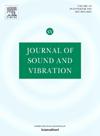考虑安装效应的低雷诺数双同向螺旋桨气动声学模拟
IF 4.9
2区 工程技术
Q1 ACOUSTICS
引用次数: 0
摘要
在低雷诺数条件下,对两个近距离并排安装的同向旋转螺旋桨的声辐射进行了数值研究。吊塔式螺旋桨是飞机分布式电力推进结构的代表,已有文献对吊塔式螺旋桨进行了实验研究。它们由六叶XPROP-S螺旋桨组成,以恒定的俯仰角以7000 rpm的转速运行。考虑了零超前比工况。数值模拟采用两步混合方法进行。首先进行不可压缩大涡模拟,计算流场。在第二步中,使用高阶有限元方法获得了具有安装效应的音调和宽带噪声预测。首先以单挂式螺旋桨为例验证了数值方法的性能。然后将数值方法应用于双螺旋桨构型。声学结果成功地与文献中的实验数据进行了比较,并提供了对声音产生机制的进一步见解。特别地,对于这种零推进比螺旋桨结构,强调了考虑螺旋桨-螺旋桨气动相互作用以获得准确的噪声预测的重要性。在声学模拟中加入安装效应也可以改善低频范围内的预测。本文章由计算机程序翻译,如有差异,请以英文原文为准。
Aeroacoustic simulations of two co-rotating propellers at low Reynolds number with installation effects
In this study, the sound radiated by two co-rotating propellers mounted side-by-side in close proximity is investigated numerically under low Reynolds number conditions. The pylon-mounted propellers, previously studied experimentally in the literature, are representative of the propellers equipping distributed electric propulsion architectures for aircraft. They consist of six-blade XPROP-S propellers operating at a rotational speed of 7000 rpm with constant pitch angle. Operating conditions at zero advance ratio are considered. The numerical simulations are carried out using a two-step hybrid approach. In the first step, an incompressible large-eddy simulation is performed to compute the flow field. In the second step, tonal and broadband noise predictions with installation effects are obtained using a high-order finite-element approach. The performance of the numerical approach is first verified for a single pylon-mounted propeller. The numerical methodology is then applied to the two-propeller configuration. Acoustic results are successfully compared to experimental data from the literature and further insights into the sound generation mechanisms are provided. In particular, for this zero-advance-ratio propeller configuration, the importance of accounting for propeller–propeller aerodynamic interactions to obtain accurate noise predictions is highlighted. Including installation effects in the acoustic simulations is also found to improve the predictions in the low frequency range.
求助全文
通过发布文献求助,成功后即可免费获取论文全文。
去求助
来源期刊

Journal of Sound and Vibration
工程技术-工程:机械
CiteScore
9.10
自引率
10.60%
发文量
551
审稿时长
69 days
期刊介绍:
The Journal of Sound and Vibration (JSV) is an independent journal devoted to the prompt publication of original papers, both theoretical and experimental, that provide new information on any aspect of sound or vibration. There is an emphasis on fundamental work that has potential for practical application.
JSV was founded and operates on the premise that the subject of sound and vibration requires a journal that publishes papers of a high technical standard across the various subdisciplines, thus facilitating awareness of techniques and discoveries in one area that may be applicable in others.
 求助内容:
求助内容: 应助结果提醒方式:
应助结果提醒方式:


